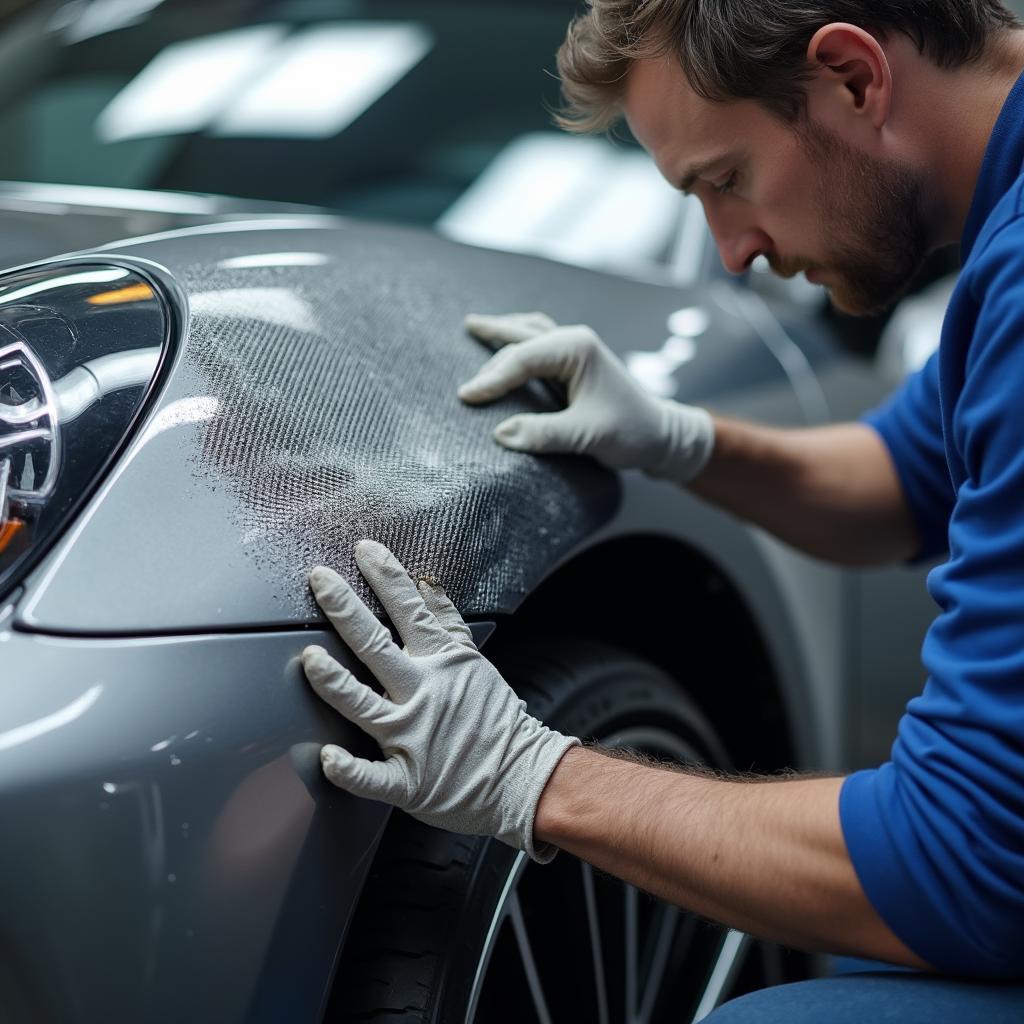When it comes to car body repair, aluminium mesh is rapidly gaining traction as a cutting-edge solution. This innovative material offers numerous advantages over traditional repair methods, making it a preferred choice for both professionals and car enthusiasts.
What is Aluminium Mesh Car Body Repair?
Aluminium mesh car body repair is a technique that utilizes a fine, woven aluminium mesh to bridge and reinforce damaged areas on a vehicle’s body. This mesh acts as a skeleton, providing a strong and durable foundation for the subsequent application of body filler and paint.
Advantages of Aluminium Mesh for Car Body Repair
Compared to traditional methods, aluminium mesh offers several key advantages:
- Lightweight: Aluminium is significantly lighter than steel, making it ideal for minimizing added weight to the vehicle.
- Corrosion Resistance: Aluminium naturally forms a protective oxide layer, making it highly resistant to rust and corrosion, even in harsh weather conditions.
- Strength and Durability: Despite its lightweight nature, aluminium mesh possesses excellent tensile strength, ensuring a long-lasting repair.
- Versatility: Aluminium mesh can be easily cut and shaped to fit various contours and complexities of car body panels.
- Faster Repair Times: The application process is typically faster than traditional methods, reducing downtime and labour costs.
How Aluminium Mesh Repair Works
- Surface Preparation: The damaged area is thoroughly cleaned, sanded, and prepped to ensure proper adhesion of the mesh.
- Mesh Cutting and Shaping: The aluminium mesh is carefully cut and shaped to match the contours of the damaged area, ensuring a precise fit.
- Mesh Application: Using a specialized adhesive, the aluminium mesh is securely bonded to the prepared surface.
- Body Filler Application: Once the adhesive cures, body filler is applied over the mesh, smoothing out any imperfections and restoring the panel’s original shape.
- Sanding and Finishing: After the body filler hardens, the repaired area is meticulously sanded and finished to create a seamless transition with the surrounding bodywork.
- Priming and Painting: The repaired section is primed and painted to match the vehicle’s original colour, completing the restoration process.
When to Consider Aluminium Mesh Repair
Aluminium mesh is an excellent solution for a wide range of car body damage, including:
- Dents: From minor door dings to larger dents, aluminium mesh provides a strong foundation for repair.
- Rust Holes: The corrosion resistance of aluminium makes it ideal for patching rust holes and preventing future rust formation.
- Cracks: Aluminium mesh can effectively bridge and reinforce cracks in car body panels, restoring structural integrity.
- Collision Damage: In some cases, aluminium mesh can be used for minor collision repair, offering a lightweight and durable alternative.
Choosing the Right Aluminium Mesh for Your Needs
When selecting aluminium mesh for car body repair, consider the following factors:
- Mesh Size: Different mesh sizes are available, each suited for specific repair needs. Finer meshes are ideal for small dents and imperfections, while larger meshes are more appropriate for larger areas of damage.
- Mesh Weight: The weight of the mesh influences its strength and flexibility. Heavier meshes offer greater strength, while lighter meshes provide more flexibility for contoured surfaces.
- Adhesive Compatibility: Ensure that the adhesive you choose is compatible with both the aluminium mesh and the type of material your car body is made from.
Tips for Successful Aluminium Mesh Car Body Repair
- Proper Surface Preparation: Thoroughly cleaning and preparing the surface is crucial for optimal adhesion and a long-lasting repair.
- Accurate Mesh Cutting: Take your time to accurately cut and shape the aluminium mesh for a precise fit.
- Secure Bonding: Apply adequate adhesive and ensure proper curing time for a strong and durable bond.
- Skilled Body Filler Application: Use high-quality body filler and apply it evenly over the mesh, avoiding air pockets or voids.
- Patience and Attention to Detail: Achieving a professional-grade repair requires patience, attention to detail, and a steady hand during the sanding and finishing stages.
Conclusion
Aluminium mesh car body repair is a modern and effective solution for a wide range of vehicle damage. Its lightweight nature, corrosion resistance, and impressive strength make it a preferred choice for both professionals and DIY enthusiasts. By understanding the advantages, application process, and key considerations, you can confidently embrace this innovative technique for your car body repair needs.
FAQs
Q: Is aluminium mesh repair suitable for all car body materials?
A: While aluminium mesh can be used with various materials, it’s essential to choose a compatible adhesive for optimal bonding.
Q: Can I perform aluminium mesh repair myself?
A: While possible, aluminium mesh repair requires a certain level of skill and experience. If you’re unsure, seeking professional assistance is recommended.
Q: How long does an aluminium mesh repair last?
A: With proper installation and care, an aluminium mesh repair can last for the lifetime of the vehicle.
Q: Is aluminium mesh repair more expensive than traditional methods?
A: The cost can vary depending on the extent of the damage, but aluminium mesh repair often offers comparable or even lower costs than traditional methods, especially when considering long-term durability.
Q: Where can I purchase aluminium mesh and related supplies?
A: Aluminium mesh and repair supplies are available at most automotive parts stores and online retailers.
Need further assistance with car diagnostics and repair? Contact our team of experts 24/7 via WhatsApp: +1(641)206-8880 or Email: [email protected]. We’re here to help!



